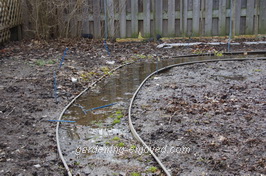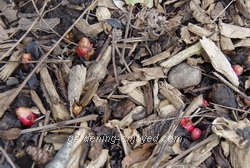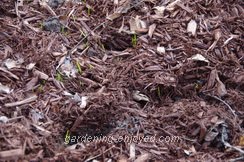| Back to Back Issues Page |
 |
|
Dallying In The Dirt, Issue #165 --- The Rhubarb is hinting at pie, soon. April 11, 2014 |

As promised, here it is Friday morning and I’m “Dallying.” Managed to rip out the old river and am now contemplating the new layout. Should be able to contemplate for at least a week before I actually start moving dirt and bricks. The bathroom reno is seriously cutting into my gardening time but the shower was leaking. The huge snow load that we experienced this year has certainly recharged the ground water levels. This week we had a 24 hour rain that added to that. It also made the load of old drywall in the back of the truck much heavier when I got it to the dump. I think I paid $10 extra to dump rain water. I have this interesting phenomenon in the low part of the back garden. The rubber edging on both sides of the gravel path creates this mini lake. The beds are very wet but have no standing water but the path, between the edging, fills with water and leaves me with this little winding river between the beds. You would think that the gravel paths would allow
for water to drain through more quickly. The path is a bit lower than the beds back there and renewing that gravel is part of this year’s list. The loose gravel on top does have a fairly solid limestone base under it but that type of path drains elsewhere on the property. It’s not really a problem, just a curiosity.  Yesterday it really was quite warm, about 17̊C, (63̊F)and I spent a few moments ignoring the bathroom reno and wandered around the drier parts of the garden looking for signs of spring. The Crocus thomasinianus are proliferating under the Walnut and the front beds are showing multiple shoots from the mass of Tulips that are planted there. It will be glorious again in a few weeks. The Witch Hazel is in full bloom and some of the Daylily clumps are pushing up new shoots. It is almost the middle of April and it’s still pretty quiet out there. The most encouraging sign was the curled red shoots of the Rhubarb clumps pushing through. We may have pie for breakfast again by the middle of May. One of my Rhubarb clumps needs to be transplanted because the Yew shrub beside it, has now grown big enough to keep it in the shade. As soon as that bit of soil is a little dry, the large excavation that is required to dig up
a Rhubarb root, will be undertaken and a new location will have to be chosen. Good rich soil with lots of compost or manure if I can find some will be incorporated. Rhubarb is a very heavy feeder and will only give those thick red stalks that make the good breakfast pie if the clump is well fed.
Yesterday it really was quite warm, about 17̊C, (63̊F)and I spent a few moments ignoring the bathroom reno and wandered around the drier parts of the garden looking for signs of spring. The Crocus thomasinianus are proliferating under the Walnut and the front beds are showing multiple shoots from the mass of Tulips that are planted there. It will be glorious again in a few weeks. The Witch Hazel is in full bloom and some of the Daylily clumps are pushing up new shoots. It is almost the middle of April and it’s still pretty quiet out there. The most encouraging sign was the curled red shoots of the Rhubarb clumps pushing through. We may have pie for breakfast again by the middle of May. One of my Rhubarb clumps needs to be transplanted because the Yew shrub beside it, has now grown big enough to keep it in the shade. As soon as that bit of soil is a little dry, the large excavation that is required to dig up
a Rhubarb root, will be undertaken and a new location will have to be chosen. Good rich soil with lots of compost or manure if I can find some will be incorporated. Rhubarb is a very heavy feeder and will only give those thick red stalks that make the good breakfast pie if the clump is well fed. Now it’s time to answer a few of my reader’s questions. Don’t forget to check the front page of the Website for frequent short ideas for current gardening activities. Sandra Asks? I’m writing in regards to my sago palm that was doing so well in Feb. with new growth that got 3 ft. and than turned yellow on me and I don’t know what to do with it. I don’t know if the lighting changed I didn’t move them, and didn’t over water please help me, we did fertilize them with plant food and don’t know if that made it worse or not, signed yellow and sad. |
| Back to Back Issues Page |
 I spent a great deal of time and money last fall cleaning up the large beds in the backyard and covering them with mulch. I had resisted mulching them because they contain the
I spent a great deal of time and money last fall cleaning up the large beds in the backyard and covering them with mulch. I had resisted mulching them because they contain the